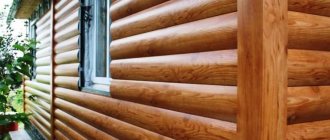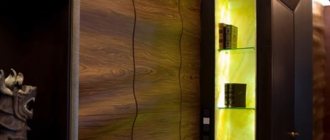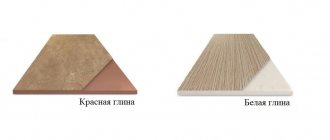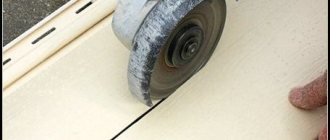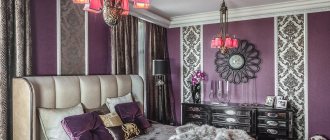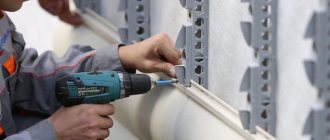These are the following options:
The wood siding facade and roof are the same color, but the roof is a darker shade
- Dark roof and light facade
. This is the most popular and common color combination. The traditional style, where the walls have light colors and the roof is darker, always looks very advantageous. In this case, additional techniques look good - such as contrasting finishing of the base and window casings. You can finish it in a classic style: a dark roof and a facade made of light siding. - The roof and facade are in the same color.
You can paint the roof and facade the same way. This option is a single color combination, which looks a little boring and will not appeal to everyone. - The option where the roof is lighter than the facade
. The main attention here is drawn to the walls of the house; the roof support elements, door and window openings are made in the same color. This option may appeal to those who like unusual options.
We have previously reviewed various options for siding panels and recommended bookmarking this article.
Metal siding
Metal siding consists of profile panels made of galvanized steel sheets 0.40-0.65 mm thick with a special decorative coating resistant to the external environment.
Its main functions when cladding the facade are:
- protection of the structure of the walls of the building from natural and mechanical influences;
- giving the building's exterior an aesthetically finished look.
Metal siding panels are cold rolled and, using the shafts of special rolling equipment, are given the required shape. The elements of addition to metal siding have a complex profile shape, which is obtained by bending using manual or automatic bending machines.
Galvanized steel, having received the appropriate shape, receives a multilayer protective coating consisting of layers:
- zinc (front and back);
- anti-corrosion coating (on the front and back sides);
- primers (from the front side);
- protective paint coating (on the reverse side);
- polymer coating.
The following can be used as a polymer coating for the front surface of metal siding:
- polyester (marked as PE or REMA) – gives the surface of the front side of metal siding a gloss or matte roughness. Typically, siding with such a coating lasts up to 20 years;
- plastisol (labeled as PVC) – imitates the relief texture of the front surface of the finishing material. This protective coating lasts for more than 30 years;
- pural (labeled as PURAL) – protects the shade of the front side from fading and lasts on average for 25 years;
- polyvinylidene fluoride (labeled as PVDF) – increases the service life of siding to 50 years.
The length of metal siding panels ranges from 0.5 to 6 meters, width - 0.2-0.25 meters. These sizes are optimal from the point of view of minimizing waste.
Production of material
The production technology of galvanized siding is simple and consists of several stages:
- Hot galvanized steel is cold rolled through a special machine. Solid rollers of various sizes give the steel sheet the desired shape. To change the shape of the finished sheet, you simply need to change the required rollers. Thanks to this simple manipulation, manufacturers offer collections of different forms of siding.
- Steel sheets are connected in a special way into panels according to size.
- The metal is coated with primer, which ensures a strong connection between the paint and varnish coatings and the base.
- The panels are coated with special polymer coatings to protect against corrosion, environmental influences and aggressive substances. Polymers are also applied to give the steel an imitation of a specific texture (possibly in several layers).
- The product is painted with high-strength modern dyes and fixatives.
- The last layer is in the form of a protective film. It is necessary during transportation and storage - from deformation, scratches and damage. After installation, the film is removed.
Thus, the steel sheet goes through several processing steps, which provides the material with increased strength in operation.
Metal soffit
The metal soffit is made using planks:
- with smooth,
- perforated,
- partially perforated surface.
Perforation of the surface allows the finishing material to breathe without accumulating moisture vapor from precipitation.
This type of siding is used mainly for finishing eaves and slopes on the under-roof side of the roof, as well as gables.
Soffit panels have special locking elements, which allows them to be accurately fixed to each other. The structure of metal soffits is attached to the surface frame using self-tapping screws. Metal soffit panels have a single color.
Soffits
Eaves and roof "wings" also require proper protection and ventilation. For these purposes, it is customary to use soffits, which cover the internal visible part of the roof in contact with the surrounding space.
Vinyl soffits
HOLZPLAST soffits are a high-quality and practical solution that goes well with the siding of this manufacturer. For its developments in the field of roofing and finishing materials, the Holtsplast company has repeatedly received the Brand of the Year award. Durable and highly functional soffits complement the facade finishing and ensure proper ventilation of the under-roof space.
GRAND LINE soffits - eaves finished with GRAND LINE soffits are well ventilated, extending the service life of the roofing. Their installation does not take much time, and the result exceeds expectations. Several color options, optimal panel geometry and modern design, high strength and the best price/quality ratio.
Metal soffits
Metal soffits with beautiful perforations are used both in combination with metal and vinyl siding. Well protected from corrosion, they not only cope well with the task assigned to them, but are also an integral part of the gable design of any modern building.
AQUASYSTEM soffits occupy a worthy place in the product line of this manufacturer. The material of manufacture is sheet steel with an anti-corrosion coating and a paint layer. There is no doubt about the quality and durability of Aquasystem soffits, because the company specializes in the development and production of drainage systems.
Wall siding
Wall siding is produced in the form of panels with a smooth surface and an angular profile in a single or double herringbone pattern .
Another type of profile form of wall siding is the “ship beam” . This siding is made in the form of panels with a surface identical in profile and texture to the deck of an old ship.
The molded profile of wall siding gives the lined wall surface a voluminous effect. This finishing option is classic. It is used to cover the facades of residential buildings and office or industrial buildings.
The panels are installed on a pre-assembled structure made of a wooden frame or metal profile. The panels tightly joined to each other, fixed in a horizontal position with self-tapping screws, form a single structure, the surface of which does not fade from the bright sun and serves as reliable protection for the walls from destruction and mechanical influences.
The color palette of wall siding panels is presented on the market in single-color options.
Wood siding
According to the characteristics, the material is close to MDF. Raw materials - crushed wood with the addition of cellulose and additives. During production, this mixture is heated to a high temperature and pressed.
The surface is similar to natural wood and can imitate any type of wood. The thickness of the material is 9 mm, the length is 5.5 m, the width is from 11.5 to 15.5 cm. When finishing the facade, the panels are connected using the tongue-and-groove method and secured with self-tapping screws on the sheathing or wall.
Available in 4 types of surface structure and 28 colors.
In Russia, they prefer to use lining instead of wooden siding, but abroad such material is considered expensive and even prestigious. In our country, only 2 companies offer wooden siding - Abtko (USA) and Werzalit (Germany).
Flat siding
The metal base of flat siding (its second name is flat) is rolled aluminum. Thanks to the aluminum base, this type of metal siding is absolutely not susceptible to corrosion and can easily withstand high temperatures.
It is light in weight and at the same time is not inferior in strength characteristics to other types of metal siding.
The only disadvantage of such siding is the loss of its original shape due to impact impacts.
Unlike other types of metal siding, panels of this type do not have a special groove. When mounted on a horizontal frame, flat siding panels are laid vertically in the structure and secured with self-tapping screws. The metal base of such siding is coated with a protective polymer layer after installation is completed. The polymer coating makes this material look like lining.
Most often, flat siding is used for cladding industrial buildings and trade pavilions due to the high fire safety requirements placed on them.
Vinyl siding
Long rectangular panels for facade cladding. Dimensions: 3-4 m long, 20-25 cm wide. Material thickness - 1 mm.
Production technology is extrusion, in which molten raw materials are forced under pressure through a molding hole. The raw materials include vinyl powder, modifiers, and pigments. After profiling, it cools and hardens, maintaining the given shape. In a similar way, a surface relief is formed that imitates the structure of natural wood.
Manufacturers use two main extrusion methods.
Monoextrusion. The raw material has a homogeneous structure and is colored in the mass. The front and back surfaces are the same color.
Coextrusion. The panels are multilayer. Each layer is made from raw materials with specific characteristics. Coextrusion is a complex technological process. The method allows you to vary the characteristics of each layer, adjusting certain properties of the raw material. The multilayer structure is formed so that the inner layers provide strength and resistance to deformation, and the outer layers protect from external negative influences.
To reduce the price of vinyl siding, some companies use recycled materials in production. It's called greyback. It forms the inner layer of the material, and no additives, modifiers or pigments are introduced into the raw material. The quality decreases because of this. You can distinguish material from recycled materials by the appearance of the “wrong side” - it differs in color from the front side. The use of such cladding is permissible only if maximum efficiency is needed, and it does not matter how aesthetically pleasing the material looks. Panels made from recycled materials can withstand use only in mild climates.
The thickness of high-quality vinyl siding should be the same over the entire panel area and fixed for different batches.
The palette includes more than 700 colors. This allows you to accurately select the required shade of the cladding. High-quality pigments contain titanium dioxide, which ensures color stability. This element is white, so light, pastel, soft colors fade the least.
Advantages:
- environmental Safety;
- installation on any bases, walls of different configurations;
- resistance to sunlight, moderately acidic, alkaline chemical compounds;
- resistance to moisture, corrosion, rotting;
- withstands temperature changes ranging from -50 to +50°C;
- ease of finishing and maintenance;
- durability - lasts up to 50 years.
During installation, it is necessary to take into account the high coefficient of compression (expansion) during cooling and heating. Even daily temperature changes can slightly change the linear dimensions of the panels. To avoid deformation, the fastening is not performed rigidly. The holes for fastenings are oblong; the structure must have temperature gaps.
Vinyl siding façade decoration is not fire-resistant; it melts and burns quickly. Therefore, remember about fire safety: do not light a fire, do not carry out welding work near the lined facade.
You can buy vinyl siding Mitten, Vinylon, Deke, Grand Line, Northside, etc.
Metal siding "wood"
Wood-look metal siding has a front surface that imitates the smoothness of a wooden board or the roundness characteristic of a log.
Such a coating, unlike wood, does not require subsequent periodic tinting, additional varnishing or treatment with antiseptic compounds. In addition, cladding a building with panels with a wooden pattern is much cheaper than cladding it with natural wood.
Metal siding with a flat wood-like pattern is used for exterior decoration of facades of administrative and commercial buildings.
In turn, siding that imitates log masonry is popular in the design of the facades of country houses, luxury cottages and adjacent buildings.
Installation of metal siding “under wood” is carried out to a frame made of metal or wood, which makes it possible to additionally lay a layer of heat-insulating material. The wooden pattern of the surface of the panels makes their joining during installation visually invisible.
Types or types of galvanized siding
Depending on the chosen project and building design, you can easily select the required type of siding. The most popular of them with an imitation of a wooden surface:
- block house;
- with a beam effect;
- ship plank;
- with a stone effect;
- color spectrum.
Block-highs and timber-effect panels imitate the texture and shape of logs. Shiplap has the appearance of a flat wood façade and can be painted to resemble wood. It is used for finishing (horizontally) large buildings, and not only houses, but also public buildings - cafes, restaurants, factories, warehouses. Stone imitation panels have the appearance of natural stone in various shades. A rich range of siding colors can be chosen to match the same color and style as the fence and roof of the building.
For each type of metal siding, the manufacturer offers a huge selection of components and fittings:
- for framing doors and window openings;
- for joining profiles;
- for decoration of building corners;
- starting and finishing bars.
The components match the color scheme and give the building façade a neat and finished look. If desired, you can choose components in contrasting shades. Such home design options will stand out from other buildings.
Metal siding "under the stone"
Metal siding “to look like stone” is made from galvanized and polymerized panels, visually similar in design and texture to brick or original masonry. The pattern of stone or brick can have either a horizontal or vertical arrangement. The relief front surface of the galvanized profile is protected by a polymer layer.
Metal siding with a three-dimensional pattern “like stone or brick” is used for exterior finishing of the facade of respectable country houses in a continuous way, or as an ornament in the area of the foundation and plinth of country houses.
Other criteria for choosing siding and roof colors
A house with a blue roof and white facade siding will look very beautiful and well-maintained. In order to choose the color of the siding and roof as best as possible, it is not enough to be guided only by their combination. You should definitely pay attention to the surroundings of the house and site. For example, it is recommended to pay attention to your neighbors’ houses. This doesn't mean you have to copy them. By taking into account the color schemes of nearby buildings, you can best determine for yourself whether you want your house to stand out against their background, or whether you will be in solidarity and maintain the general line of cottages standing on the street. In addition, you should not neglect the surrounding landscape . So, with densely planted bushes and trees around the house, a roof and facade in close to natural green and brown tones will harmonize perfectly. If the house is located near the beach, blue, coral, turquoise and beige colors and shades are more suitable for painting the house. Read also the article “Design of facades: how to choose material and finishing method.”
Installation of metal siding
The technique of connecting and installing metal siding panels does not require specialized skills and can be done on your own.
A wooden frame (from dry wood timber) or metal structure is constructed on the previously prepared outer surface of the wall.
To insulate the walls, heat-insulating material is laid in the cells of the frame, which is fixed with dowels. Panels of metal siding and additional elements can be easily cut to size using metal scissors.
Starting from the outer corners of the building, from the bottom up, the façade is covered with metal siding panels using specially provided locking locks and self-tapping screws. Before laying each subsequent row, the evenness of the fixed panels is checked using a building level. Upon completion of the façade cladding with metal siding panels, the corners and edges of the structure are decorated with finishing strips and corresponding additional elements.
To decorate the joints, corners and edges of the panels, you should select additional elements that match the shade:
- simple or complex external and internal angles;
- connecting H-rails;
- overhead slats;
- platbands;
- initial and final slats.
Choosing siding for cladding
For the roof, not only vinyl siding is used, but also wood, metal, and galvanized materials. The vinyl version is used more often because of its strength, lightness, reliability and low cost. Panels made of siding are thin sheets 3 m long. Each panel has several profiled 10- or 12-centimeter strips equipped with locks.
Roof siding configurations may vary. Two types of soffits are often used:
- soffit with partial perforation;
- siding without perforation.
It is recommended to use the first option. It makes it possible to ensure proper ventilation of the internal space of the roof.
For the roof, not only vinyl siding is used, but also wooden materials
Advantages
The fact that metal siding belongs to the middle price category of finishing materials is explained by its following advantages:
- High strength. This type of external wall cladding, without changing the geometric parameters and without collapsing, withstands seasonal precipitation and temperature changes;
- Durability. The material does not lose the aesthetics and attractiveness of the front surface for a long time. In the presence of a PVDF polymer layer, the service life of metal siding reaches 50 years;
- Moisture resistance. The polymer layer reliably protects the metal base from corrosion;
- Resistant to deformation. Suitable for cladding buildings that have not undergone a shrinkage period; - fire safety. The material is not subject to fire;
- Immunity to rodents and insects;
- Simplicity and ease of installation. Cladding work can be easily done independently, without the involvement of experienced specialists. The set of panels includes fastening elements and installation instructions;
- Easy to remove dirt. Water without chemically active agents can be used to care for the surface.
A wide palette of colors from calm and natural to bright and richly dense shades provides a huge field of activity for designers.
What to pay attention to
- Sheathing structures with metal siding can be done at any time of the year, regardless of weather conditions and temperatures.
- To prevent the repeatability of the “wood” or “stone” pattern from being noticeable, it is advisable to mix panels from different packages before installing them.
- For finishing, you should purchase metal siding only from well-known brands. Manufacturers who value their reputation use only high-quality materials to produce metal siding. Dents or scratches will never appear on this siding during installation.
- Selecting shades or combinations thereof that are suitable for cladding the roof, gables and facade of the building will not be difficult, since the color palette of metal siding of all varieties is marked with the generally accepted Ral coding.
Aluminum siding: application features, advantages and disadvantages
Types of siding for the house - which one is better to choose
How to choose the right panels
Siding has not lost its popularity for many years, thanks to its affordable price and a wide range of advantages. Multifunctional siding panels can simultaneously perform several functions at once, insulating, preserving, protecting and decorating the house.
The very first siding appeared in the 19th century and consisted of wooden panels.
Modern manufacturers bring to the market a large number of varieties of siding. They differ not only in pricing policy, but also in their technical parameters. And, of course, they have both pros and cons.
Vinyl
It is considered one of the lightest materials. This type of siding is the most popular. It is most often chosen for finishing residential buildings of various designs.
| Advantages | Flaws |
| Wide variety of textures and colors; High corrosion resistance; Withstands serious temperature changes (-50⁰С – +50⁰С); Light weight and environmentally friendly. | During long-term operation under conditions of sharp temperature fluctuations, it can give a “wave” effect, changing its size; Poor level of heat conservation; Low strength of the material. |
Acrylic
Another popular type of siding, created on the basis of acrylic polymer. Acrylic siding can be made in horizontal or vertical stripes. This type of high-strength siding panels was created later than vinyl, and the use of modern technologies made it possible to produce siding panels from acrylic with imitation of natural wood and metal.
| Advantages | Flaws |
| Good resistance to temperature changes (-80⁰С – 80⁰С); Expanded palette of color shades; Brighter, more saturated shades; Lightweight and easy to care for; Quick installation. | High price; Acrylic material can collect dust on its surface, as if “attracting” it; With prolonged use it can lose color brightness. |
Metal
This type of siding is made using sophisticated technology and is a “multi-layer cake.” The basis is a sheet of especially durable steel with additional anti-corrosion treatment and zinc coating. The front part is a polymer layer; an external coating is applied to the back side - varnish or durable paint.
Expert opinion
Levin Dmitry Konstantinovich
If you need to siding your home with a high-performance material, consider working with metal siding.
| Advantages | Flaws |
| Long period of operation (up to 40-45 years); Siding panels retain their color brightness for up to 15-20 years; Large selection of colors; Resistance to loads, temperature fluctuations and external influences. | High price; It is heavy, which makes the installation process difficult; Poor thermal insulation qualities; May be subject to corrosion in chipped or scratched areas; Low sound insulation. |
Fiber cement (fiber concrete)
Siding panels of this type are made from a mixture of sand, cement, reinforced fibers and various mineral fillers (both synthetic and natural ones can be used). On the front side, a textured layer resembling stone or wood is applied to the material.
| Advantages | Flaws |
| Large selection of colors; High fire resistance; Simple and convenient to install; Easy to maintain; Long service life (is the most durable material); Good strength, reliability and sound insulation: Eco-friendly; If necessary, you can easily repaint it in a different shade. | Increased level of moisture absorption; Heavy weight; It is characterized by increased fragility. |
Ceramic
This is a type of fiber-reinforced concrete siding. The composition of the material additionally includes clay. Also, during manufacturing, the outer side of such siding is covered with a ceramic layer. The texture of the material can imitate stone, wood, brick, plaster or rocky relief.
| Advantages | Flaws |
| High fire resistance; Increased strength (this type of material is actively used for finishing houses in earthquake-prone areas); Eco-friendly and hypoallergenic; Large selection of textures and colors; Long service period. | High price; Heavy weight, which adds difficulties during transportation and installation; Difficulty in installation - ceramics are difficult to cut; if done incorrectly, they quickly burst and lose their aesthetic appearance. |
Wood
In the production of modern wood siding, manufacturers use compressed wood waste. This type of finishing material is losing popularity due to the need to annually coat the facade with additional protective antiseptic compounds. But, thanks to its high environmental friendliness, wooden siding is not yet completely a thing of the past.
| Advantages | Flaws |
| Gives the facade a natural, natural look; Environmental friendliness; Good heat-saving characteristics. | Requires care and financial expenses for additional processing; Fire hazardous material; It quickly absorbs moisture, which is why it is prone to deformation. |
Tsokolny
This type of siding is made of polyvinyl chloride and is not very popular.
| Advantages | Flaws |
| Simple and easy to install; It is light in weight; Good frost and moisture resistant qualities; It features a large selection of textures and colors. | Requires regular additional treatments (crack sealing, plastering); Highly susceptible to external factors (mechanical shocks, temperature changes, melt water; Doesn't retain heat well. |
Foamed
Siding of this type is made on the basis of foamed polyvinyl chloride. It has a porous structure and is quite in demand when carrying out finishing work.
| Advantages | Flaws |
| Rust resistant; Good heat and sound insulation properties; Light weight, which ensures simple and quick installation; Aesthetic, with a wide range of textures and colors to choose from. | High price. |
Block house
The siding of this option is visually similar to wooden logs. This material can be produced in various shades, including light ones (cream, pistachio, silver, snow-white). The main feature of this material is its ideal compliance with our climatic conditions. Due to this, blockhouse siding is actively used for finishing dachas and houses in any climatic zones of our country.
| Advantages | Flaws |
| Impact resistance; High resistance to aggressive manifestations of the external environment; Long period of operation. | Low level of fire resistance; The need for constant updating (paint and varnish coating); Susceptible to biocorrosion. |
The best combination of roof color and facade shade
Photo: gray roof and light yellow siding facade is one of the most successful combinations. And finally, we will recommend how to choose siding to match the color of the roof, based on specific color combinations. So, the best combinations will be:
- With a blue roof - white, yellow and beige facade. Light blue, pink and gray siding will look good.
- With a dark blue roof - each of the siding colors indicated in the first paragraph. A gray facade will look a little less harmonious.
- With a brown roof - white, light blue, turquoise and light green facade. Slightly less successful are yellow, beige and gray.
- With a dark green roof - white, yellow, pink and beige facade.
- With a cherry roof - all of the above listed facade shades. Slightly less harmonious - turquoise and light green facade siding.
- With a dark gray roof - all of the above listed facade shades. Slightly less successful are turquoise and gray colors.
We will also consider combinations that should be avoided if possible:
- With a blue and dark blue roof - a turquoise and light green facade.
- With a brown roof - a pink facade.
- With a dark green roof - light blue, turquoise, light green and gray facade.
Advice!
You can see your home in various colors and shades with your own eyes using special PC programs. They will allow you to determine in real time, by changing the color of the roof, facade and various façade elements, the best combination in your opinion. Video instructions for using such programs will help you quickly understand and achieve the desired result.
Thus, we have determined the main criteria for choosing the siding color for the facade that is most suitable for the various shades of the roof. Remember that the price for the services of a professional designer will be quite high. Therefore, we recommend that you listen to our recommendations, and also be sure to use a visualizer program to visually evaluate the selected combination.
Read also about how to decorate the facade of a house with your own hands.
Material selection
Before you buy roof siding in a hardware store or arrange delivery from online resources, you need to understand what materials it is made from and which one is better to choose:
- Galvanized siding . Walls and roofs are covered with metal. In stores you can find galvanized siding, which looks like a rounded beam in shape and has a wooden texture on the surface. The metal is not afraid of mechanical influences and direct sunlight. An additional coating protects it from the damaging effects of moisture. However, at joints, scratches and chips, the metal can quickly rust and ruin the appearance of the skin.
Galvanized siding Source www.equipnet.ru
- Aluminum soffit . Roof siding is a solid sheet of aluminum covered with a decorative layer. Thanks to the additional surface coating, aluminum is more resistant to environmental factors.
Aluminum soffit Source kertas.yola.access.ly
- Vinyl siding . Made from PVC. This material is lightweight and is not afraid of prolonged exposure to moisture and sunlight. In addition to this, PVC is inexpensive and has a high durability.
Vinyl siding Source dom-krovli198.ru
- Vinyl siding (soffit) . It is considered the best material for lining roof frame overhangs. This is due to high levels of resistance to environmental factors, ease of installation, and low price. Perforated parts allow air to pass under the material and prevent mold from forming on the wooden roof frame.
Vinyl siding (soffit) Source klub-masterov.ru
Previously, wooden lining was considered the most popular material for lining overhangs. However, the beautiful appearance could not overshadow the disadvantage associated with moisture. With prolonged exposure, it quickly destroyed the wood and rendered the filing unusable.
Wooden lining makes a beautiful, but relatively short-lived filing Source makler.ua
On a note! In addition to the siding, you need to purchase fasteners. Self-tapping screws should be smaller in width than the holes located at the junctions of the decorative coating sheets.
Vinyl soffits
When hemming the cornice with vinyl soffits, it is important to adhere to the following rules:
- Before direct use, the material is stored in places with limited access to sunlight at a temperature of no more than +60 degrees.
- The installed panels must move freely horizontally.
- When securing the panels, do not apply force to prevent damage.
- It is best to attach soffits using self-tapping screws.
- The fasteners are not screwed in until the cap is completely sunk; it is recommended to leave a gap of at least 1 mm. Pressing too hard may cause the panel to break.
- It is not recommended to use sealant between soffits and corner elements, as well as between panels and profiles.
Advantages of the material
Sheathing the cornice with siding is a modern design solution. Siding for eaves is called soffit. The material has many advantages over other finishing options. Positive qualities usually include:
- Versatility: this type of siding is intended for cornices, but is also widely used for floors;
- Diversity. They sell various types of siding, as well as decorative additions to it. Wide color palette available;
- Does not require any additional coverage;
- Environmental friendliness of materials used in production;
- Resistance to various types of influence: biological, temperature changes and high humidity;
- Compliance with fire safety standards;
- Easy to install: even inexperienced builders can carry them out; you can work alone;
- Relatively low cost of material and finishing costs;
- Small mass of siding. The use of the material will not affect the overall weight of the structure and will not cause a risk of collapse;
Installation of eaves with siding (video)
The box for filing the pediment cornice is made of two boards, one of which is attached to the wall. Soffits are not easy to install, but if you approach the work responsibly, everything will work out. Overhang panels not only perform a functional load, but also protect the roof from excess water during rain or melting snow.
Roof soffits will allow you to implement any architectural solutions. Thanks to a wide range of components and types, finding the right option will be easy.
Soffits for overhangs are installed in several stages:
- Two strips are installed on the roof eaves.
- J- and F-profiles are fixed to the strip located near the wall.
- The soffits are aligned to the width of the overhang.
- One part of the panel is inserted into the groove, and the other is fixed on the mounted strip.
- The joints between the soffits and roof siding are covered with a plank.
Soffits are not easy to install, but if you approach the work responsibly, everything will work out
How much does siding installation cost?
Recently, home owners are increasingly choosing siding. This material can be used to hem the roof eaves without any problems. Of course, some use wood, metal profiles or other materials of their choice, but cornice siding is best suited for these purposes. So:
- Nowadays there is a large amount of siding available in markets and stores. Its cost varies. It all depends on what material it is made of.
- So, for example, finishing the roof eaves with siding can cost any amount. The average price varies from 70 rubles per piece to 1300 rubles.
- When ordering siding for eaves, you can give preference to any size in which it is produced.
Note. When starting a conversation about what kind of siding covering the eaves should be, it is necessary to take into account that in addition to the price of the material itself, there are other points. They are presented in the table below.
How much will it cost to install a cornice using siding?
| Job | Price (m) |
| Installation of wooden boards for cornices. | 120-200 rubles. |
| Lathing. | 80-100 rubles. |
| Installation work. | 200-250 rubles. |

